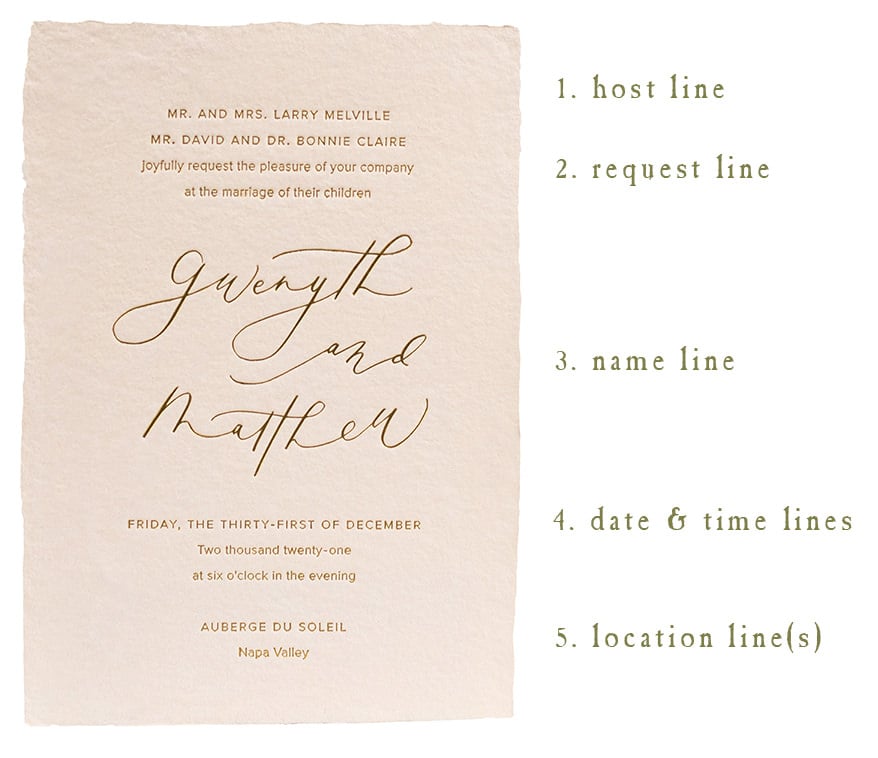
This is the line that typically denotes who is hosting, or paying for the bulk of the wedding. Traditionally, only the bride’s parents were listed on the invitation. Today, there are numerous options as your parents may or may not be contributing to your wedding financially, and sometimes couples simply would like to include both sets of parents. Other factors, such as whether the host(s) are married, divorced or remarried will also affect how this portion of the invitation is worded - our staff is happy to help in these more complicated situations.
The request line usually hints at what kind of location the wedding will take place at. "The honor of your presence" is reserved for a ceremony taking place in a house of worship such as a church or temple, while "the pleasure of your company" is reserved for non-religious locations. Additionally, if both sets of the couple's parents are hosting, this line would specify "at the marriage of their children" as well.
Here is where the names of the couples are listed and is often one of the more visually striking aspects of your invite. Traditionally the bride always preceded the groom and was referred to by her first and middle names only, while the groom was referred to by his first, middle and last name.
Today, some couples use only their first names or show both full names. It comes down to personal preference as well as your invitation style.
Traditionally, all time and dates are spelled out. Time of day is spelled out using o’clock or half after xx o’clock and no part of the time is ever capitalized. Evening begins at five o’clock, otherwise it is considered afternoon from noon until four o’clock.
Today, designs have changed such that numerals are often used for time and date for a more modern feel. If you go this route, be consistent throughout the invitation suite and use numerals for each event.
If the reception is at the same location as the ceremony, the reception information can be listed at the bottom of the invitation (“Reception to follow” or “Dinner and dancing to follow” or “Celebration to follow”). If the reception is at a different location, there is typically a separate reception card included in the invitation suite. Very traditional or formal invitations forgo location information altogether on the invitation and include it in a separate card.
If a specific dress code is desired, let your guests know by including a line in the bottom left or right corners of the wedding invitation. Only the first letter of this line is ever capitalized on the wedding invitation. Traditional examples include:
Black tie: tuxedo or dinner suit for men, formal gown for ladies
Formal/Black tie optional: suit and tie for men, fancy dress for ladies
Semi-formal: suit and tie for men, cocktail dress for ladies
Cocktail attire: suit with tie optional for men, cocktail dress for ladies
Garden party: summer suit for men, summer dress for ladies.
Listing registry information on your wedding invitations is considered in poor taste. Traditionally, registry information is simply shared by word of mouth. A modern alternative, which makes this information subtly and easily accessible, is to put it on your wedding website. Direct guests to your website by listing it at the bottom of your invitation, or include it on a separate web card insert. Note that it is acceptable to include your registry information on a shower invitation, since the invitation is being generated by a friend or relative rather than the bride or groom to be.
If you are having an adults only wedding ceremony and/or reception, let your guests know on a separate details card, or on your RSVP card. Suggested wording examples:
1. “While we love all of your children, it is preferred that alternative care be arranged for those under ten during Saturday’s ceremony and reception”
2. “We hope you will understand our decision to make the wedding children-free, and take the opportunity to celebrate in style”
3. “To allow all our guests to relax and enjoy themselves, we have chosen to make our special day adults only. We thank you for your understanding”
4. “Please note this will be an adults only celebration”
In general, save the date cards should be sent 6-8 months prior to your wedding. Invitations should be sent 6-8 weeks prior to your wedding, with an RSVP date of about 4-5 weeks prior to your wedding. This allows guests time to reserve travel and lodging if necessary, and gives you time to tally your final guest count.